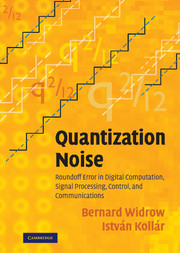 Quantization Noise
Quantization Noise Book contents
- Frontmatter
- Contents
- Preface
- Acknowledgments
- Glossary of Symbols
- Acronyms and Abbreviations
- Part I Background
- Part II Uniform Quantization
- Part III Floating–Point Quantization
- Part IV Quantization in Signal Processing, Feedback Control, and Computations
- Part V Applications of Quantization Noise Theory
- 19 Dither
- 20 Spectrum of Quantization Noise and Conditions of Whiteness
- Part VI Quantization of System Parameters
- APPENDICES
- Bibliography
- Index
19 - Dither
from Part V - Applications of Quantization Noise Theory
Published online by Cambridge University Press: 06 July 2010
- Frontmatter
- Contents
- Preface
- Acknowledgments
- Glossary of Symbols
- Acronyms and Abbreviations
- Part I Background
- Part II Uniform Quantization
- Part III Floating–Point Quantization
- Part IV Quantization in Signal Processing, Feedback Control, and Computations
- Part V Applications of Quantization Noise Theory
- 19 Dither
- 20 Spectrum of Quantization Noise and Conditions of Whiteness
- Part VI Quantization of System Parameters
- APPENDICES
- Bibliography
- Index
Summary
Dither inputs are externally applied disturbances that have been used in control systems and in signal processing systems to alleviate the effects of nonlinearity, hysteresis, static friction, gear backlash, quantization, etc. In many cases, dither inputs have been used to “improve” system behavior without there being a clear idea of the nature of the improvement sought and without any method for designing the dither signal other than empiricism. It is the purpose of this chapter to explain the uses of dither signals in systems containing quantizers. We will employ the mathematical methods developed herein for the design of dither signals and for analysis of their benefits and limitations.
DITHER: ANTI-ALIAS FILTERING OF THE QUANTIZER INPUT CF
When the input signal to a uniform quantizer has statistical properties allowing it to satisfy QT I or QT II, the PQN model can be applied to describe the statistical behavior of the quantizer. This is a linear model, and from the point of view of moments and joint moments, the quantizer acts like a source of additive independent noise. This type of linear behavior would be highly desirable under many circumstances.
When the quantizer input is inadequate for satisfaction of QT II, it is possible to add an independent dither signal to the quantizer input so that the sum of input and dither does satisfy QT II. Then the quantizer exhibits linear behavior and we can say that it is linearized.
- Type
- Chapter
- Information
- Quantization NoiseRoundoff Error in Digital Computation, Signal Processing, Control, and Communications, pp. 485 - 528Publisher: Cambridge University PressPrint publication year: 2008
- 3
- Cited by
